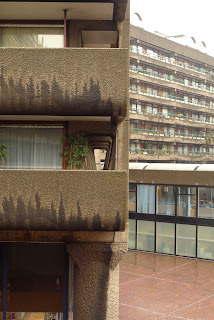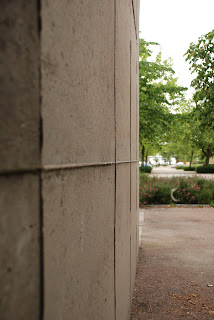 I like brutalism.
I like brutalism.a good few architects like brutalism.
some non-architects like brutalism.
a huge amount of people use the word concrete in a derogatory way. for the sake of the argument I'll assume these people don't like brutalism, probably not even the brick brutalism of Klas Anshelm, GKC or Bernt Nyberg.
how is the architect supposed to relate to the views of the public?
how do you avoid making a bland populist design? should you avoid making a populist design? as whatever you do will be the part of the daily lives of thousands of people, what responsibility do you, as an architect, have to those people?
 some of these problems were dwelt upon a long time ago, as far back as in the 18th century but that time in writings on landscaping. there is a quote from sir Uvedale Price in Nikolaus Pevsner's Visual Planning and the Picturesque which quite clearly explains the difference between landscaping on the one hand and food and drinking on the other, but it could as well be used to discuss the differences between architecture on the one hand and art or music on the other:
some of these problems were dwelt upon a long time ago, as far back as in the 18th century but that time in writings on landscaping. there is a quote from sir Uvedale Price in Nikolaus Pevsner's Visual Planning and the Picturesque which quite clearly explains the difference between landscaping on the one hand and food and drinking on the other, but it could as well be used to discuss the differences between architecture on the one hand and art or music on the other:'it can hardly be doubted, that what answers to the beautiful in the sense of tasting, has smootheness and sweetness for its basis, with such a degree of stimulus as enlivens, but does not overbalance those qualities; such, for instance, as in the most delicious fruits and liquors. take away the stimulus, they become insipid; increase it so as to overbalance those qualities, they then gain a peculiarity of flavour, are eagerly sought after by those who have acquired a relish for them, but they are generally less adapted to the general palate. this corresponds exactly with the picturesque; but if the stimulus be encreased [sic] beyond that point, none but depraved and vitiated palates will endure, what would be so justly termed deformity in objects of sight.'
 and that cuts straight to the heart of the matter, the issue of architecture's ubiquitiouness, how it is impossible to escape. it is no problem to me – a meagre whisky drinker at the best of times – if the person sitting next to me on the tube likes to drink whisky that tastes like pouring an entire fishing village down your throat, because I won't have to experience it myself. and for those amongst us who like our buildings a little rougher, a little more elemental, I guess we might be seen as having 'acquired a relish' for this. and once we're hooked we just go deeper and deeper until finding the ultimate trip: usually a stage involving Lewerentz's flower kiosk, or in partciularly bad cases Anshelm's extension to Lewerentz's last flat. but at times it can be wise to remember Price's words and try to put a restrain on ourselves. maybe try to be a little more populist and not let the roughness be all encompassing. because as beautiful as those buildings can be to the person looking for that kind of thing just as overpowering can they be to the person coming there just looking for a book, or to get a medical examination.
and that cuts straight to the heart of the matter, the issue of architecture's ubiquitiouness, how it is impossible to escape. it is no problem to me – a meagre whisky drinker at the best of times – if the person sitting next to me on the tube likes to drink whisky that tastes like pouring an entire fishing village down your throat, because I won't have to experience it myself. and for those amongst us who like our buildings a little rougher, a little more elemental, I guess we might be seen as having 'acquired a relish' for this. and once we're hooked we just go deeper and deeper until finding the ultimate trip: usually a stage involving Lewerentz's flower kiosk, or in partciularly bad cases Anshelm's extension to Lewerentz's last flat. but at times it can be wise to remember Price's words and try to put a restrain on ourselves. maybe try to be a little more populist and not let the roughness be all encompassing. because as beautiful as those buildings can be to the person looking for that kind of thing just as overpowering can they be to the person coming there just looking for a book, or to get a medical examination. I know we should design buildings able to stand for hundreds of years, and that during that time taste changes and they may become cherished by thousands – however rough or smooth they are – but I'd say that as a rule of thumb the closer a building is to everyday life the less challenging it should be. and the further removed from the matters of living and the closer it is to ritual and memory the rougher it can be. thus the only sorts of buildings entirely in the realm of architecture in the views of Adolf Loos – the monument and the tomb – can be as rough and uncompromising as the architect feels like.
I know we should design buildings able to stand for hundreds of years, and that during that time taste changes and they may become cherished by thousands – however rough or smooth they are – but I'd say that as a rule of thumb the closer a building is to everyday life the less challenging it should be. and the further removed from the matters of living and the closer it is to ritual and memory the rougher it can be. thus the only sorts of buildings entirely in the realm of architecture in the views of Adolf Loos – the monument and the tomb – can be as rough and uncompromising as the architect feels like.come to think of it, if you subscribe to that view the Monument to Rosa Luxemburg and Karl Liebknecht would pretty much be the perfect monument. too bad the rest of Mies' work seems to be monuments too, and smooth ones at that ...
No comments:
Post a Comment